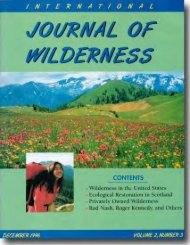Download full PDF - International Journal of Wilderness
Download full PDF - International Journal of Wilderness
Download full PDF - International Journal of Wilderness
Create successful ePaper yourself
Turn your PDF publications into a flip-book with our unique Google optimized e-Paper software.
shortage <strong>of</strong> mountainous areas on the<br />
West coast open to air access. These two<br />
wilderness areas help retain a spectrum<br />
<strong>of</strong> recreational opportunities.” The announcement<br />
brings the number <strong>of</strong> designated<br />
<strong>Wilderness</strong> Areas in New<br />
Zealand to 10. These are managed to<br />
preserve indigenous biodiversity and<br />
pristine natural features and exclude all<br />
buildings, structures, signs, trails, or<br />
any other sign <strong>of</strong> human presence.<br />
For more information, visit the<br />
New Zealand Department <strong>of</strong> Conservation<br />
website at www.doc.govt.nz/<br />
Whats-New/Media-Releases.asp.<br />
<strong>Wilderness</strong> Photographer<br />
Galen Rowell Killed in<br />
Plane Crash<br />
Acclaimed outdoors photographer<br />
Galen Rowell and his wife, Barbara<br />
Rowell, were killed along with two others<br />
in a plane crash near the Bishop<br />
(Inyo County) airport on their way<br />
home from a photo workshop class in<br />
Alaska. Rowell, 62, was known for his<br />
wilderness photography in the California<br />
Sierra and across all seven continents.<br />
Rowell’s death shocked many<br />
outdoors people who considered him<br />
to be one <strong>of</strong> the world’s pre-eminent<br />
photographers <strong>of</strong> natural settings and<br />
an avid outdoorsman who brought remote<br />
areas into the public realm. In<br />
1984, Rowell received the Ansel Adams<br />
Award for his contributions to the art<br />
<strong>of</strong> wilderness photography. In 1992, he<br />
received a National Science Foundation<br />
Artists and Writers Grant to photograph<br />
Antarctica. Over his career, Rowell<br />
made trips to the mountains <strong>of</strong> Nepal,<br />
India, Pakistan, China, Tibet, Africa,<br />
Alaska, Canada, Siberia, New Zealand,<br />
Norway and Patagonia. He is credited<br />
with making the first one-day ascents<br />
<strong>of</strong> Mount McKinley in Alaska and<br />
Kilimanjaro in Africa as well as first ascents<br />
<strong>of</strong> Himalayan peaks such as<br />
Cholatse and the Great Trango Tower.<br />
Reprinted from San Francisco Chronicle.<br />
Protecting Our Diverse<br />
Heritage Conference Set<br />
for April 2003<br />
The conference on Protecting Our Diverse<br />
Heritage: The Role <strong>of</strong> Parks, Protected<br />
Areas, and Cultural Sites is an<br />
interdisciplinary joint conference <strong>of</strong> the<br />
George Wright Society (GWS) and the<br />
National Park Service (NPS), and incorporates<br />
two <strong>of</strong> the country’s leading<br />
conferences on parks and cultural sites.<br />
The George Wright Society Biennial<br />
Conference is the United States’ largest<br />
interdisciplinary conference on protected<br />
areas, a term which includes a<br />
broad array <strong>of</strong> places—both cultural<br />
and natural—managed by different<br />
entities: national, state/provincial, and<br />
local parks; historic and cultural sites;<br />
research areas and designated wilderness<br />
within national and state forests,<br />
grasslands, wildlife refuges, and other<br />
public lands; tribal reserves; marine,<br />
estuarine, freshwater, and other aquatic<br />
sanctuaries; private land-trust reserves;<br />
and similarly designated areas. The<br />
GWS is unique among pr<strong>of</strong>essional<br />
organizations because it encourages<br />
dialogue and information exchange<br />
among all the people needed for protected<br />
area conservation, from historians<br />
to biologists, managers to<br />
researchers, public agencies to private<br />
organizations, academics to field personnel.<br />
The GWS conference brings<br />
people together to share problems and<br />
information, hear new perspectives,<br />
and contemplate critical questions<br />
about the future <strong>of</strong> protected areas.<br />
The Cultural Resources 2003<br />
(CR2003) conference will be the second<br />
in a series <strong>of</strong> nationwide forums,<br />
convened by the NPS, for discussing<br />
how to increase awareness <strong>of</strong> the value<br />
<strong>of</strong> cultural resources, for strengthening<br />
communications among NPS cultural<br />
resources staff and NPS partners, and for<br />
discussing best practices and recent developments<br />
in cultural resources management.<br />
CR2003 participants represent<br />
the <strong>full</strong> range <strong>of</strong> people who work with<br />
cultural resources: archaeologists, architectural<br />
historians, archivists, conservators,<br />
cultural anthropologists, cultural<br />
resources managers, historians, historic<br />
architects, interpreters, landscape architects,<br />
property managers, and many<br />
more. CR2003 will address heritage<br />
preservation planning and technical services,<br />
National Historic Landmarks and<br />
National Register properties, community<br />
preservation planning, and more.<br />
The event is an excellent opportunity<br />
to address issues related to science<br />
and the management <strong>of</strong> wilderness,<br />
parks, and other natural areas. For<br />
more information, visit the conference<br />
website at www.georgewright.org/<br />
2003.html<br />
The Gondwana Link:<br />
Connecting Ecosystems <strong>of</strong><br />
Southwestern Australia<br />
Southwestern Australia is internationally<br />
renowned for its ecological diversity.<br />
Tens <strong>of</strong> millions <strong>of</strong> years <strong>of</strong><br />
evolutionary interaction across some<br />
<strong>of</strong> the Earth’s oldest land surfaces has<br />
created a major “biodiversity hotspot.”<br />
Sadly, massive clearing <strong>of</strong> vegetation<br />
for agriculture has fragmented the old<br />
evolutionary pathways. Combined<br />
with climate change and other sources<br />
<strong>of</strong> land degradation, the long-term<br />
viability <strong>of</strong> much <strong>of</strong> the region’s<br />
biodiversity is in doubt.<br />
The Gondwana Link Project, led by<br />
The <strong>Wilderness</strong> Society <strong>of</strong> Australia,<br />
is an initiative that will effectively link<br />
the ecosystems <strong>of</strong> inland Western Australia<br />
(WA) with the wetter forests <strong>of</strong><br />
the southwest corner. It aims to restore<br />
ecological connectivity from the<br />
<strong>International</strong> <strong>Journal</strong> <strong>of</strong> <strong>Wilderness</strong> DECEMBER 2002 • VOLUME 8, NUMBER 3 45










